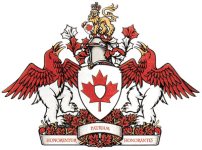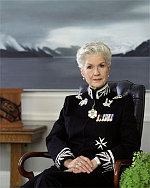About the Royal Heraldry Society of Canada
Mission
The mission of the Royal Heraldry Society of Canada and its Branches is to promote the Art and Science of Heraldry, particularly Canadian heraldry, and to encourage an interest in the subject among Canadians. Since the Society's foundation more than three decades ago, the RHSC has never lost sight of its objectives and continues to this day informing and educating Canadians and assisting them and their institutions in the acquisition of properly granted coats of arms. During its first twenty-five years, the Society was the driving force toward the establishment of Canada's own body for the granting of arms.
History of the Royal Heraldry Society of Canada
The Heraldry Society of Canada (now "Royal Heraldry Society of Canada") was founded in Ottawa by a group of enthusiasts under the leadership of L/Cdr. Alan Beddoe. The founding meeting was held on October 25th, 1966, at the Beacon Arms Hotel in Ottawa, where a full Board of Officers and Directors was formed under the presidency of Alan Beddoe (for a full list of the founders and their arms, click Founding Fathers).
The Society was subsequently incorporated under federal charter and granted charitable status. Its objectives, briefly stated, were:
- To promote greater interest in heraldry among Canadians;
- To promote the establishment in Canada of a Canadian Heraldic Authority; and
- To bring to its members, through the journal Heraldry in Canada, interesting and informative articles on topics relating to Canadian heraldry.
The Society quickly developed into a national body, with members in all provinces and territories - and even in many countries outside Canada.
The Canadian Heraldic Authority
The second of the above objectives was attained - very largely through the vigorous efforts of the Society - on June 4th, 1988. On that day, Prince Edward proclaimed at Rideau Hall Letters Patent from the Queen empowering the Governor General to exercise Her Majesty's powers as Queen of Canada in respect of the granting of armorial bearings in Canada. From this event was born the Canadian Heraldic Authority, a description of which appears elsewhere on this website. The first Chief Herald of Canada was Robert Watt, at that time President of our Society, and his first two heralds, Athabaska (Charles Maier) and Saint Laurent (Auguste Vachon) were also Society members.
The Patriation of Canadian Heraldry
It should be noted that until the Authority was established, a Canadian wishing a grant of arms had to petition either the College of Arms in London or - if of Scots descent - the Court of the Lord Lyon in Edinburgh. Canada was the first (and so far only) Commonwealth country outside the UK to be permitted to grant arms in Her Majesty's name, and Canadians and Canadian institutions have taken full advantage of this privilege. The Heraldry Society is proud of its role in bringing about this momentous event.
Education
Both before and after the achievement of its most high-profile objective, the Society has vigorously pursued its other objective - less glamorous, perhaps, but of equal importance - the education of Canadians in the science and art of heraldry. To this end, it has published three books: Canadian Heraldry, by Alan Beddoe and Strome Galloway, A Canadian Heraldic Primer, by Dr Kevin Greaves and its French adaptation, L'Abécédaire canadien de l'héraldique, by Kevin Greaves and Auguste Vachon, and is planning a fourth. On a continuing basis, it also publishes two periodicals entitled "Heraldry in Canada" and "Gonfanon". (Link to Publications)
Liaison with Other Bodies
In addition to its relationship with the Canadian public and its own members, the Royal Heraldry Society of Canada is devoted to the maintenance, fostering and development of the heraldic traditions of Canada and Canadians. It does this by :
- Advocating with governments for the protection and proper use of heraldry in Canada; and
- Liaison with the Canadian Heraldic Authority on matters of mutual concern.
Royal Designation
To crown its many years of achievement, in December, 2001, on the initiative of its then President, Dr. Kevin Greaves, the Society petitioned the Queen via the Governor General to grant the designation "Royal" to the Society's name. This privilege was granted by Her Majesty on March 20, 2002, in the year of her Golden Jubilee. The change of name to the Royal Heraldry Society of Canada was proclaimed officially at the Society's Annual General Meeting in Victoria, British Columbia, on October 26, 2002. The announcement was made by Her Majesty's then-personal representative in the Province, the Lieutenant Governor of British Columbia, the Hon. Iona V. Campagnolo, CP, OM, OBC.
In keeping with its new status a Royal Society, the RHSC held a special General Meeting held on May 3, 2003 at the Delta Hotel, Ottawa, whereby, the change of name to the Royal Heraldry Society of Canada/La Société royale d’héraldique du Canada was approved, and the President was subsequently tasked to petition for an augmentation to its arms, using the Royal Crown on the shoulders of the Shield's supporters. The augmentation to its arms was granted by Her Majesty and new arms were granted on 18 December of that year. (The Royal Heraldry Society of Canada Minutes of the Special General Meeting held on May 3, 2003 at the Delta Hotel, Ottawa).
- The Society's arms were granted by the College of Arms, London, March 6, 1972, and later amended by Supplementary Letters Patent, May 7, 2003, Grant of revised supporters and branch badges, September 15, 2004, Canadian Heraldic Authority, Ottawa.
- Iona Victoria Campagnolo, PC OC OBC (born October 18, 1932) is a Canadian politician, and was the first woman and 27th Lieutenant Governor of British Columbia. Prior to becoming Lieutenant Governor she was a Canadian politician and cabinet member in the Liberal government of Prime Minister Pierre Trudeau. Source: wikipedia, last accessed: Feb 25, 2016.









